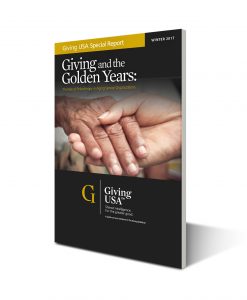Do you think of seniors (age 65+) as a primary audience for your nonprofit organization? Maybe you should.
By 2060, it is estimated that the population of Americans over 65 will climb to 98.2 million – double the estimate in 2015, according to the U.S. Census Bureau. As they age, this cohort is likely to depend on housing, healthcare, recreation, and other aging services provided by nonprofit organizations.
Despite dramatic growth in the number of seniors, new data suggests that organizations serving them may not be prepared. Many Aging Service Organizations (ASO’s) rely on a single type of income to provide the majority of operating revenue to pay for these services and are exposed to risk unless they diversify funding streams with philanthropic donations.
A newly released Giving USA Special Report, Giving and the Golden Years: The Role of Private Giving in Aging Services Organizations, questions how ASO’s will be able to fiscally bear that growth. Our Laura MacDonald co-authored the report, which provides a first-of-its-kind benchmark of the national aging services landscape, including information on state-by-state coverage and how these critical organizations are supported financially. Insights from this report will help organizations focused on serving aging populations to look at their current financial support and long-term trends to make decisions on how to ensure future financial stability.
To preview this special report, Laura MacDonald answers some key questions about the Aging Services industry.

Q: What trends do you see as significant in this report for aging services organizations?
A: Relatively little is known about the amount and sources of philanthropy dedicated to improving the quality of life for aging Americans. But, the data and information we collected on ASOs is a baseline to measure against in future years. While growth in the industry is well-documented with regard to bigger societal trends, the data we gathered about the associated philanthropic efforts is not something that has been previously examined.
We know that demand for health, housing, and other aging services will increase over the next decade and beyond. And, we know that many aging service organizations are reliant on narrow sources of revenue. As the demand increases, we strive to help nonprofit organizations diversify their revenue streams, especially from philanthropic sources, to meet this demands.
Q: How can aging service organizations set themselves up for success given they are projected to have a greater demand as the population ages?
A: Aging service organizations can adopt best practices for cultivating relationships and donations from philanthropic sources–individual donors, foundations and corporations. It takes patience and years of work to build a pipeline of engaged donors, but many aging services organizations have proven that it works. It’s about establishing a culture of philanthropy within the organization. It’s about communicating the benefits of a healthy aging population to the local community. Notably, especially among younger generations, these organizations should engage the hands and hearts before asking for monetary contributions.
Q: How would aging service organizations benefit from multiple sources of income? How could this facilitate organizational growth?
A: Developing philanthropic income decreases risk. ASO’s that cultivate philanthropic revenue allow donors to take part in a larger movement to improve the aging experience. This spirit of generosity, when combined with a shared vision, forges a connection between community, aging services organizations, and the individuals who benefit. Regardless of the size or mission of an organization, philanthropic gifts help sustain essential services and create lasting connections with the surrounding community.
Q: What role could private giving philanthropy have in aging service organizations?
A: According to the 2016 study by the National Center for Charitable Statistics, private giving philanthropy currently makes up only about 2.8% of total revenue in the aging service organization industry. In comparison, philanthropy plays a vital role in the nonprofit sector. Approximately half of all public charities in America rely on gifts, grants, and other forms of private giving to support 50 percent or more of their annual operating expenses. So, clearly there lies an opportunity to increase the percentage of philanthropy as a total of overall revenue, just compared to the national average for all nonprofits. Having multiple sources of income would help aging service organizations to ensure organizational stability and fulfill their missions to serve the aging populations.
Q: Sixty-nine percent of charitable giving comes from those born prior to 1964. What does this mean for the future of philanthropy for ASO’s in the USA?
A: This means more and more the populations doing charitable giving will be similar to the populations receiving the gifts and services. It is our job to inspire those growing up now to be as philanthropically generous as their parents.
Q: How can Benefactor Group help ASOs that look to diversify private giving?
A: Benefactor Group has over 25 years of experience to help organizations meet their fundraising goals, and we’ve partnered with many ASO’s over the years. Specifically, Benefactor Group can help an ASO build a sustainable philanthropy program. We can guide the board, leadership, and senior staff to effectively implement best practices for fundraising. We can help secure leadership and staff buy-in to the opportunity that philanthropic revenue provides, resulting in consistent and diversified fundraising revenues and committed donors.
To learn more about the opportunity for ASO’s to increase revenue, go to the Giving USA Special Report, Giving and the Golden Years: The Role of Private Giving in Aging Services Organizations is available here . If you’re interested in purchasing the article, we can provide a 30% discount code upon request. Email: [email protected].





